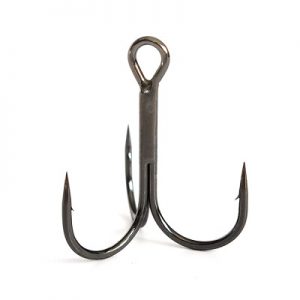When targeting striped bass, choosing the right hook type can significantly impact your success and the sustainability of the fishery. Anglers often debate whether treble hooks or single hooks are better for these prized gamefish. This guide explores the pros, cons, and best practices for both options, helping you make informed decisions for your next fishing adventure.
Design and Functionality
Treble hooks feature three prongs, offering multiple points of contact to secure fish. This design is common on lures like topwater plugs, crankbaits, and jerkbaits, where aggressive strikes or swipes from striped bass can result in better hookups. However, trebles can cause more damage to fish, particularly if they snag sensitive areas like the gills or eyes.
Single hooks, whether inline or traditional designs, have one point. They are often praised for reducing injury to fish and simplifying unhooking, especially during catchandrelease fishing. Single hooks also pose fewer risks to anglers, as they’re less likely to snag skin or gear.
Hookup Rates and Fish Retention
Treble hooks generally provide higher hookup rates due to their multiple prongs. For example, striped bass that swipe at a lure may still connect with one of the treble’s points, even if the strike isn’t perfectly timed. However, trebles can also lead to “leveraging,” where a hooked fish uses the second or third prong to shake free.

Single hooks, while less likely to foulhook fish, require precise timing and placement. Some anglers report fewer missed strikes with single hooks once the fish is securely hooked, as there’s no secondary point for the fish to exploit. Modifications, such as upsizing the hook or adjusting its position on the lure, can improve retention rates.
Impact on Fish Health
Studies comparing treble and single hooks show mixed results. While trebles are more likely to cause superficial injuries, single hooks can penetrate deeper if swallowed, leading to internal damage. For striped bass, which often strike lures headon, single hooks tend to hook the mouth cleanly, reducing mortality rates. Crushing barbs on trebles or replacing them with singles can further minimize harm.
Notably, striped bass are prone to stress during release. Single hooks allow for quicker, safer removal, which is critical for their survival. This makes them a preferred choice for conservationminded anglers.
Safety and Ease of Use
Treble hooks pose risks to both fish and anglers. Their multiple points easily snag nets, clothing, or skin, complicating unhooking. In contrast, single hooks simplify the process, reducing handling time and stress for the fish. For surfcasters or kayak anglers, this safety advantage is particularly valuable.
Modifying Lures for Single Hooks
Swapping trebles for single hooks requires careful consideration:
1. Hook Weight: Ensure the replacement hook matches the original treble’s weight to maintain the lure’s action. A digital scale helps avoid imbalances that alter swimming performance.
2. Hook Size: Upsize single hooks by 3–4 sizes compared to the treble. For example, replace a 1/0 treble with a 4/0 single to maintain hooking efficiency.
3. Testing: Always test modified lures in calm water to verify their action. Surface plugs like pencil poppers may need tail weights to compensate for shifted balance.

When to Use Each Hook Type
Treble Hooks: Ideal for fastmoving lures (e.g., topwaters, lipless crankbaits) where aggressive strikes are common. Use barbless trebles or clip one prong to reduce harm.
Single Hooks: Best for slow presentations (e.g., jigs, soft plastics) or areas with high catchandrelease traffic. They’re also safer for night fishing or crowded beaches.
Conclusion
Both treble and single hooks have roles in striped bass fishing. Trebles excel in maximizing hookups, while singles prioritize fish survival and angler safety. By understanding the tradeoffs and tailoring your setup to the conditions, you can enjoy productive fishing while supporting sustainable practices.
For those transitioning to single hooks, start with lures like needlefish or metal lips, which adapt well to modifications. Always test your gear and prioritize the longterm health of the fishery—after all, today’s releases ensure tomorrow’s catches.